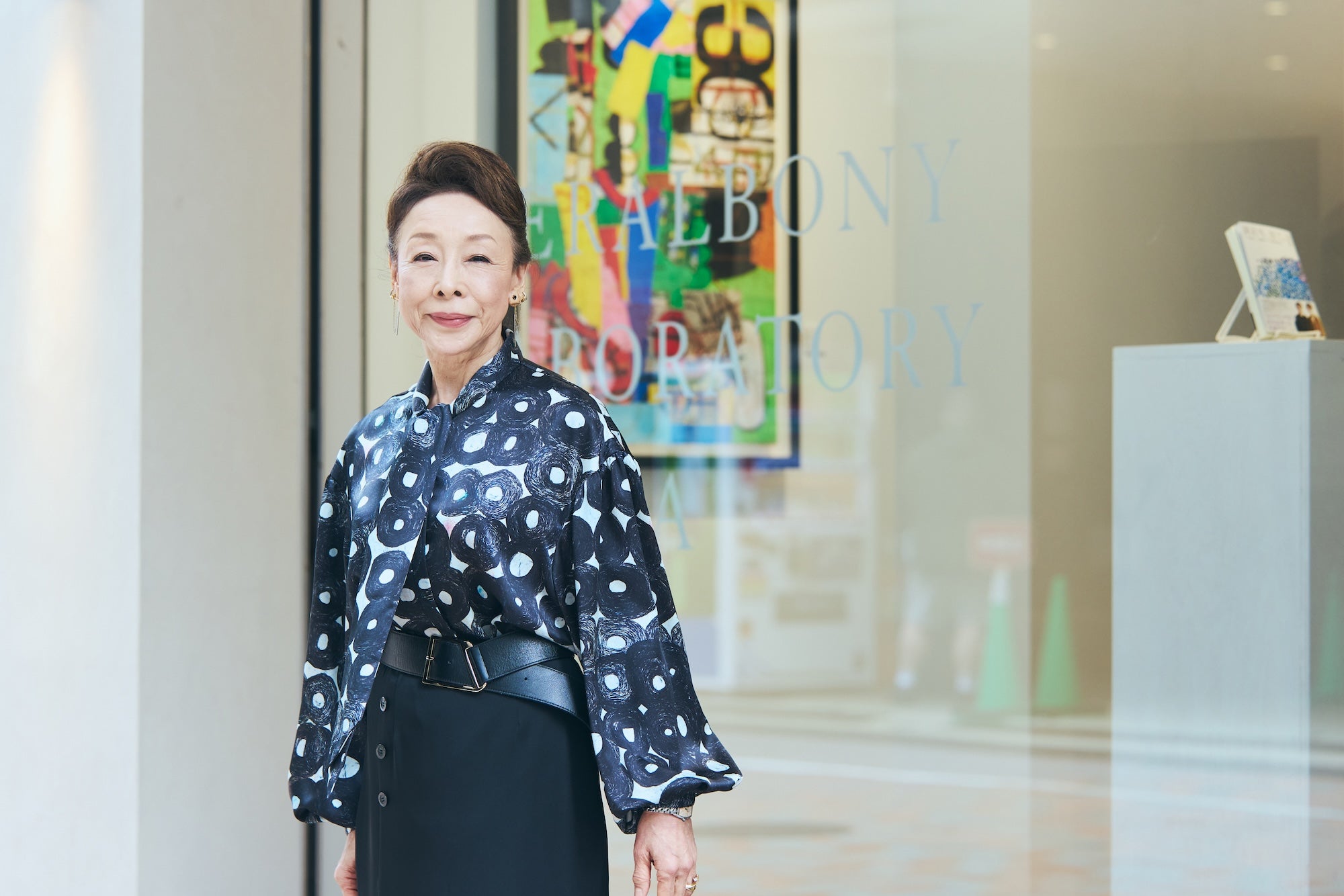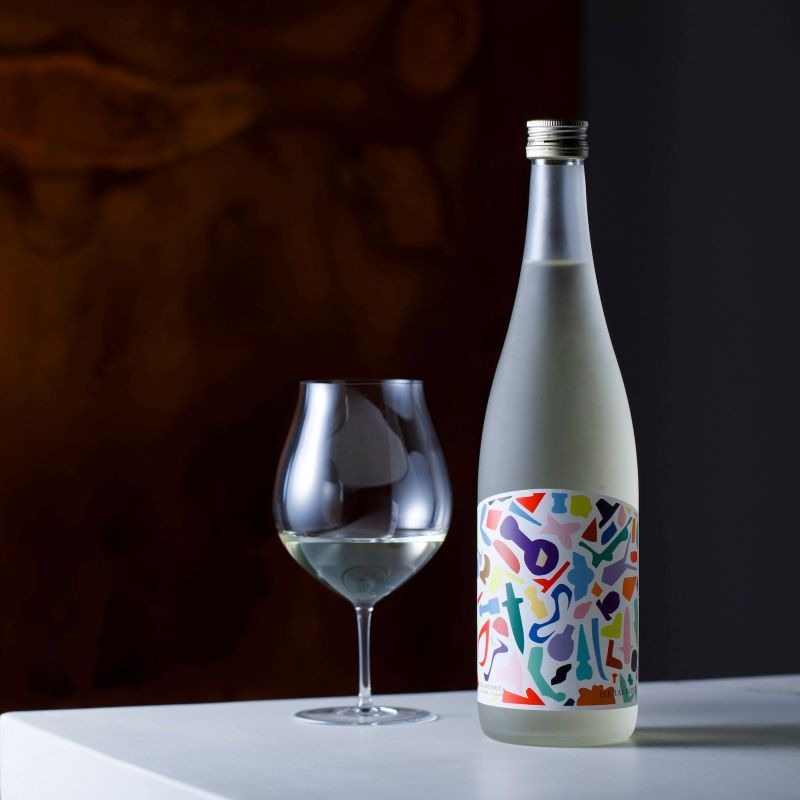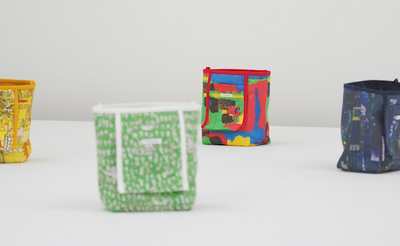The view she saw from the car window with her husband, Akira Nakao, that day. The reason she resonates with the work, not just because she "supports people with disabilities" [Interview with Shino Ikenami | Part 1]

"HERALBONY & PEOPLE" is a series where we talk to people who support HERALBONY. In this series, we interview people from all walks of life who are regularly in tune with HERALBONY's activities and business.
The sixth episode features actress Shino Ikenami. She has been a fan of HERALBONY products for a long time, so what does it mean to "wear art" for her? When we asked her about her encounter with HERALBONY at the beginning of the interview, she told us about an episode with her husband Akira Nakao, who passed away last May.
My encounter with Heralbony was not in the context of "welfare"

--The bowtie blouse from "Kuromaru" that you're wearing looks great on you.
Shino Ikenami (hereinafter, Ikenami): Thank you. The first HERALBONY item I bought was a classic blouse from "Kuromaru," also by Sanae Sasaki. I also bought a silk scarf (Mori Keisuke's "Ballad of Youth") and a few handkerchiefs. At the time, I thought, "I wish there was a wider lineup of products," but now the number of items is increasing rapidly. It's hard to keep up with the information on new products (laughs).
--You've been using HERALBONY on a regular basis, haven't you? Could you tell us how you first encountered HERALBONY?
Ikenami: I don't remember exactly when I first learned about HERALBONY. However, what made an impression on me was a few years ago when I was traveling and saw a HERALBONY art piece on display at a construction site's temporary fence (※). I remember talking to Nakao (Akira), who was sitting next to me in the car, saying "What is that?" and "It's nice." At the time, I didn't know the concept of HERALBONY, and commented on the powerful style of the work, "It must be the work of a young artist."
Because of this encounter, I didn't actually become interested in Heralbony in the context of "welfare."
*The " WALL ART MUSEUM " project involves decorating the pure white temporary fencing at construction sites with art by Heralbony's contracted artists, turning the town into an art museum.
The appeal of craftsmanship that doesn't impair the texture of art

Ikenami: After that, I started seeing HERALBONY in various places, such as watching a TV program that featured it and finding paper cups with HERALBONY art on board a JAL flight. I then read the CEO's book, "Unleash Your Uniqueness: HERALBONY Changes the World with Welfare and Art, " and learned about the company's origins and background.
Looking back, it's a shame that I wasn't able to have a proper discussion with Nakao about HERALBONY. His health had been fluctuating for about a year before he passed away, and we didn't have time to enjoy art together during that time. If he was in good health now, I would have liked to have come to the Ginza store together. We had visited many art museums together up until now. Nakao had a deep connection with the Tohoku region, and had visited there frequently even after the earthquake. I'm sure he would have said that he would like to go to HERALBONY ISAI PARK in Morioka.
I was a little depressed after Mr. Nakao passed away last spring, but after a while, I went to the "HERALBONY Art Prize 2024 Exhibition" held at the Sumitomo Mitsui Banking Corporation East Building. It was the first time I saw the original artworks.

-Did you come across HERALBONY simply as a piece of art and become interested in it?
Ikenami: Yes. I was also attracted to the way they made things that seemed to have the breath of art.
I love art museums, regardless of genre, but to be honest, some of the goods and items sold in museum shops are disappointing. They just have the art pattern printed on them, and they end up being something completely different from the original art. However, all of HERALBONY's items do not lose the strength and charm of the works themselves.
As I was reading the book, I came across an episode where the president visited Ginza Taya when he was making his first tie, wanting to make a quality that would allow the wearer to feel the texture and depth of the work, and it really struck me. I have always wanted to wear things that show art with respect for the artists and that are made with great care, so HERALBONY was something I had always wanted. 
"Wearing art" is connected to the world of kimono
--Some people may find "wearing art" to be a high hurdle, but what do you think about it, Mr. Ikenami?
Ikenami: Is it a high hurdle? For me, who has worked with kimonos for many years, the kimono is truly like "wearing art." So it's a familiar feeling to me.
For example, one of Japan's representative dyeing crafts, "Yuzen," is an art in itself, depicting various scenes with rich colors and expressing them through dyeing. "Edo Komon," characterized by its delicate patterns, is made by a stencil carver who carves intricate patterns one by one, and then glued and dyed. Even the obi belt has the artist's name on it, and high-quality kimonos are full of various details. A kimono is like wearing a work of art called dyeing all over your body.
So, in the sense of "wearing art," I feel that HERALBONY has something in common with the world of kimono.
 >> Socks Kuromaru
>> Socks Kuromaru
--It was a new realization for me that this has something in common with kimonos. I am very happy that you understand and support the power of the work itself and the attention to detail that goes into the manufacturing of the products.
Ikenami: Personally, I'm interested in welfare activities and I've been involved in them. But when it comes to HERALBONY, I'm not thinking, "I'll support it because it's a work by a person with a disability." I just find it attractive. I want to live in a society where works that are considered "amazing" are recognized and spread, and I think it's strange that the creators of such works don't get the proper spotlight. It's a good sign that various companies are now resonating with and participating in a company that is trying to make this happen. I think the times are finally catching up. I hope that this momentum will continue to expand the base.
In the second part, we ask Ikenami, who has a deep knowledge of the world of art and fine arts, about how to enjoy art and his thoughts on standing out in an era when anything that is "out of the ordinary" tends to be criticized.
>>Read the second part here: A society that treats "unusual" as evil crushes exceptional talent







 >>
>> 

